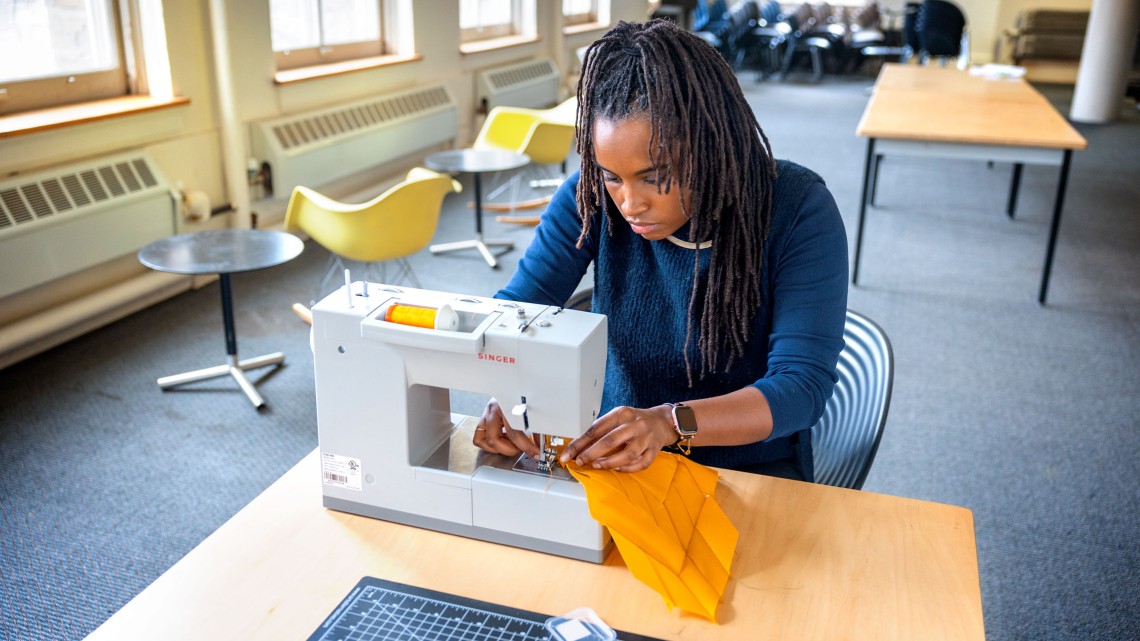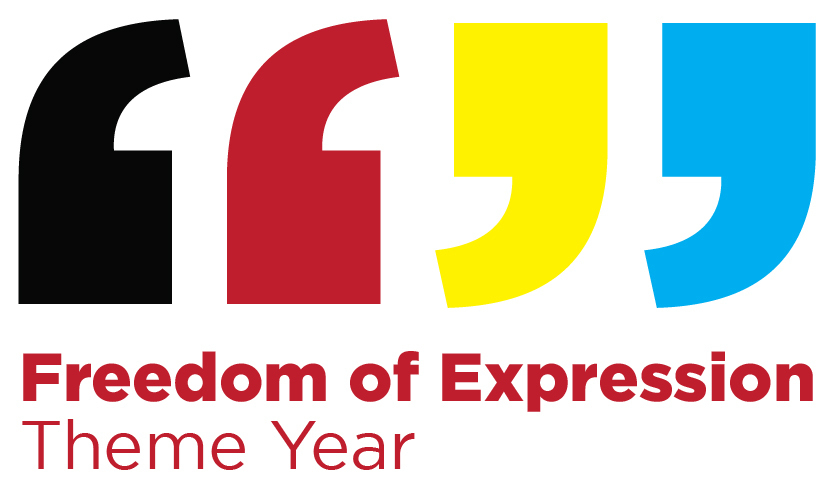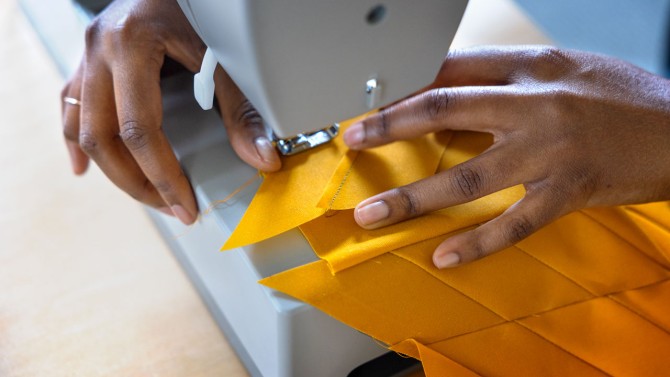
Imani Day, B.Arch. ’11, a design teaching fellow in the Department of Architecture, stitches fabric for a quilt she’s designed for “Dialectics,” her contribution to the Cornell Council for the Arts’ Freedom of Expression Exhibition, which opens March 4 in the College of Architecture, Art and Planning.
Art exhibition to explore freedom of expression theme
By James Dean, Cornell Chronicle
Projects exploring a TV movie’s impact on an immigrant child, synergies between quilting and architecture, and opportunities to foster collaboration through play are among those featured in the Cornell Council for the Arts’ (CCA) Freedom of Expression Exhibition, opening March 4 in galleries at the College of Architecture, Art and Planning (AAP).
Over several weeks, more than 20 student, faculty and alumni artists and collaborators across the university will showcase 15 projects, selected from nearly 50 submissions, in media ranging from video, drawing and painting to fabric, 3D-printed objects, music and performance.
The exhibition is presented in dialogue with the universitywide theme year, “The Indispensable Condition: Freedom of Expression at Cornell,” which has previously featured an opera performance and fashion exhibit, in addition to talks by First Amendment and other scholars. Artists can uniquely contribute to the conversation by tapping into our common humanity and providing new perspectives to help us understand our place in the world, according to CCA leaders Milton S. F. Curry, professor of architecture and senior associate dean for strategic initiatives and engagement in AAP, and Coordinator Tina DuBois.
“Art and design enable us to bring our whole selves and identity(ies) to a work and interrogate our individual humanity and our place in the world amongst other humans while also becoming vulnerable,” Curry said. “That allows for the common good to emerge through thinking about who we are, through the prism of aesthetics, space, sound and the works that artists are making.”
The CCA, which has catalyzed cross-disciplinary arts events and artist grants since its founding in 1965, and AAP will host a public reception celebrating the exhibition in Milstein Hall Dome on March 13 from 5-7 p.m. Guests can meet the artists and tour their work in the John Hartell Gallery in Sibley Hall and the Bibliowicz Family Gallery on the lower level of Milstein Hall. “We invite you to consider the practice of free expression and envision a world without it,” DuBois said. “What might become of creativity? Would authentic art cease to exist?”
A complete list of exhibition participants, dates and locations follows below. Weeks before the show, while still finalizing designs, several artists offered the Chronicle a preview of their projects.
Sopheak Sam: The Lexicon of Freedom
In a bilingual education class at his elementary school in Lowell, Massachusetts, Sopheak Sam was transfixed by a made-for-TV Disney movie, “The Girl Who Spelled Freedom,” about a young Cambodian girl who emigrates to the U.S. and wins a spelling bee. Sam, whose family emigrated from a Thai refugee camp when he was 3 years old, hadn’t yet learned about the Khmer Rouge’s genocide in Cambodia. Sam’s video installation blends film clips of the girl spelling words in English – “refugee,” “ghost” – with him spelling in Khmer, his family’s native language, which he is studying at Cornell with Hannah Phan, senior lecturer in the Department of Asian Studies (A&S), while pursuing a master of fine arts degree. A stage, school chair, custom books, painterly interventions of spelling bee guides and workbooks, and archival images complement his investigation of language and a Cambodian American diasporic identity. “I was thinking about language as a way to assimilate and acculturate into Americanness, and about this little girl who, in order to succeed, needed to learn English really fast,” Sam said. “I feel as though I need to learn Khmer at a certain pace to work through all the culture and history and literature of Cambodia, to be able to produce work that I think is worthy of producing. … I wanted to use this as a platform to be in conversation with other artists that were speaking to this feeling of freedom of expression.”
Imani Day, B.Arch. ’11: Dialectics
As an architect in Detroit, Imani Day, a design teaching fellow in the Department of Architecture (AAP), centers her work around community engagement. As a way to form deeper, longer-term connections, she began exploring textile-based practices as an interactive tool for capturing local histories. In her conversations with community members, she found that quilting evoked rich stories about families and neighborhoods, and realized their construction incorporates techniques and concepts common to architectural design and drawing, creating an opening for a more inclusive design process. For the exhibit, she plans to make a series of quilts that depict architectural drawings, building on traditional means and methods of quilting as a form of coded communication. “It’s starting to have those dialogues between something that is familiar, like quilting, versus something that’s a little more distant from everyday life,” Day said. “And then joining those two languages and techniques together, to start to have conversations about architectural representation and how that actually connects back to people in neighborhoods, and maybe to their more personal memories.”
Leighton Beaman and Zaneta Hong: The Civic Playground Project
Visitors to the John Hartell Gallery in Sibley Hall may find a table arranged with colorful, 3D-printed shapes and connecting parts, and a simple instruction: Play. It’s a small-scale exploration of the power of design and architecture to bring communities together – not only in the design process but in making things, using systems that invite participation because they are intuitive, instead of requiring highly specialized tools or knowledge. Leighton Beaman, associate professor of practice in the College of Human Ecology’s Department of Human Centered Design, and Zaneta Hong, assistant professor of landscape architecture in the College of Agriculture and Life Sciences, have applied those principles through the work of their nonprofit, General Architecture Collaborative, whose projects include a community center in Rwanda. Beaman said the ideas are grounded in research showing that shared problem solving can be a powerful conflict resolution technique, bringing together people with different backgrounds and points of view in pursuit of a common goal. The exhibition objects, which the designers refer to as toys, may be combined in innumerable ways and have no specific purpose other than to facilitate people making something together, as co-authors. “It’s a very different idea of expression,” Beaman said. “It’s not our expression, so much. It’s about this thing that facilitates expression for multiple people simultaneously.”
Tim Green ’24 and Milan Taylor ’24: Memorandum of Understanding
From March 25-29, canvas will line the walls of Hartell Gallery. For eight hours each day, Green and Taylor will fill the space in silence, expressing their thoughts and communicating together exclusively in writing. Guests will be invited to interact with the artists through note cards that will be incorporated into the piece. Green, a fine arts student in AAP who will write with black-and-white graphite, charcoal and ink, and Taylor, who is studying anthropology and archaeology in the College of Arts and Sciences, and who will work in colorful acrylic markers, hope limiting how they can communicate, and a meditative silence, prompt deeper reflection about the freedom of expression theme. “It’s critical that we place some constraints on ourselves, something that causes us and others to think about expression in a nonconventional way, calling attention to what’s happening in the space,” Green said. Added Taylor: “It seemed fitting to develop a project thinking about how open and vulnerable we wanted to be, the choice of what is shared, how the audience would interact with our work, how others express themselves within our space, and how we communicate with them. These are all big questions that we’re still contemplating.”
March 4-22: John Hartell Gallery, Sibley Hall
- Victoria Lee ’26 (AAP): Bookmark for Freedom Pages
- Sopheak Sam, M.F.A. ’25: The Lexicon of Freedom
- Imani Day, B.Arch. ’11, design teaching fellow, Department of Architecture (AAP): Dialectics
- Osiel Aldaba ’26 (AAP): Reflexiones: A Cornell Latinx Retrospective
- Adrian Aguilera, M.F.A. ’25 and Betelhem Makonnen: people the We
- Chiedza Musiiwa ’25 (AAP) and Mia Wang, M.S. AAD ’24: The Braided Garden
- Fabia St-Juste ’24 (AAP): Barbie
- Leighton Beaman, associate professor of practice, Department of Human Centered Design (CHE); and Zaneta Hong, assistant professor, Department of Landscape Architecture (CALS): The Civic Playground Project
March 11-22: Bibliowicz Family Gallery, Milstein Hall Lower Level
- Eduardo Cilleruelo Terán, design teaching fellow, Department of Architecture (AAP): Data Tactics: Information Control, and Colonization Strategies in the Data Center Technocene
- Michele Cheng, doctoral student in the field of music composition, and Seiyoung Jang, doctoral student at Harvard University: Beauty Standards
- Emma Silverblatt and Ryan Whitby, visiting critics, Department of Architecture (AAP): Echo Chamber
- Nicolau Spadoni, doctoral student in the field of Germanic Studies (College of Arts and Sciences): Bywalker
March 25-29: John Hartell Gallery, Sibley Hall
- Milan Taylor ’24 (A&S) and Timothy Green ’24 (AAP): Memorandum of Understanding
To be Announced: Live Performances
- Daniel Reza Sabzghabaei, teaching associate, Department of Music (A&S): voices of dust and trash
- Sheila Novak, M.F.A. ’25: To Know Maple
Media Contact
Get Cornell news delivered right to your inbox.
Subscribe




